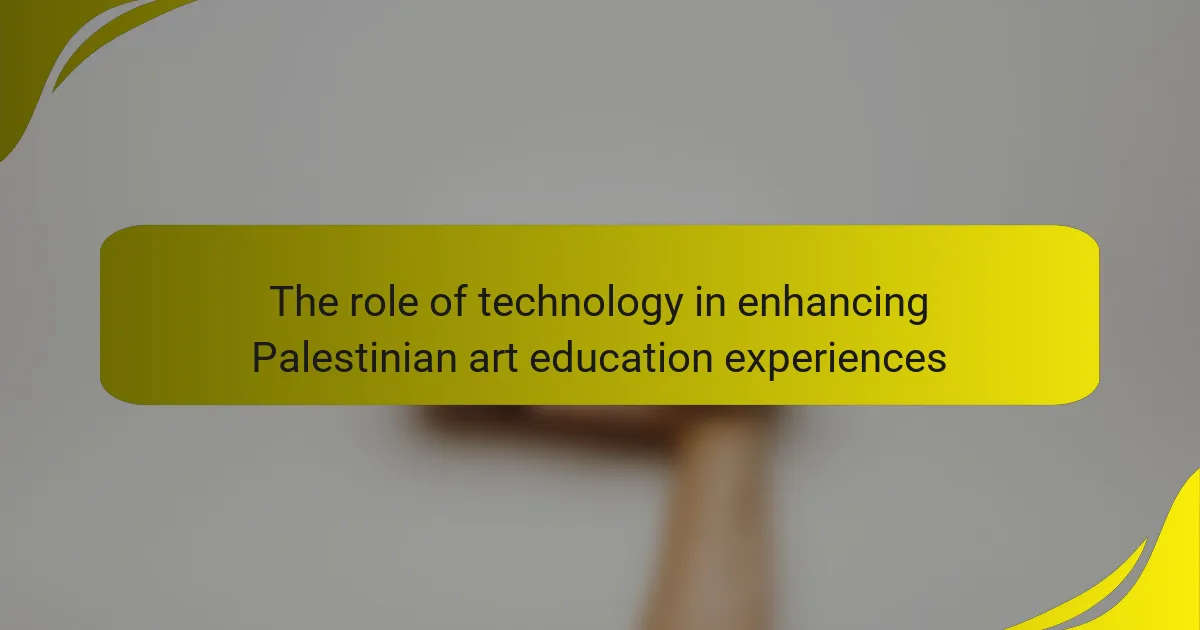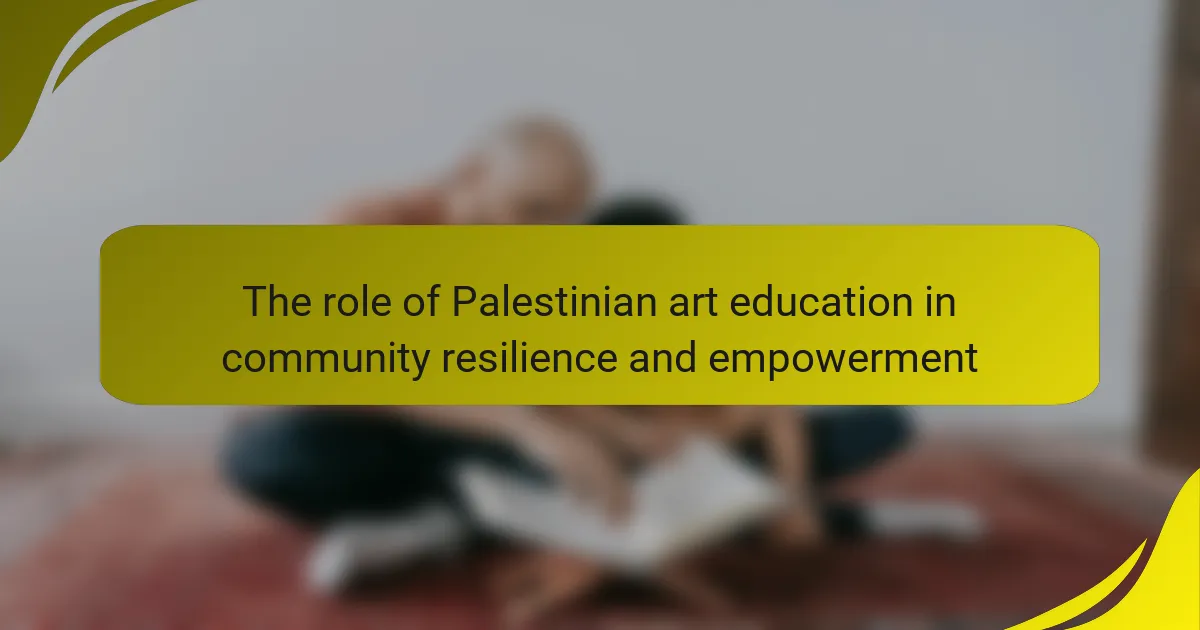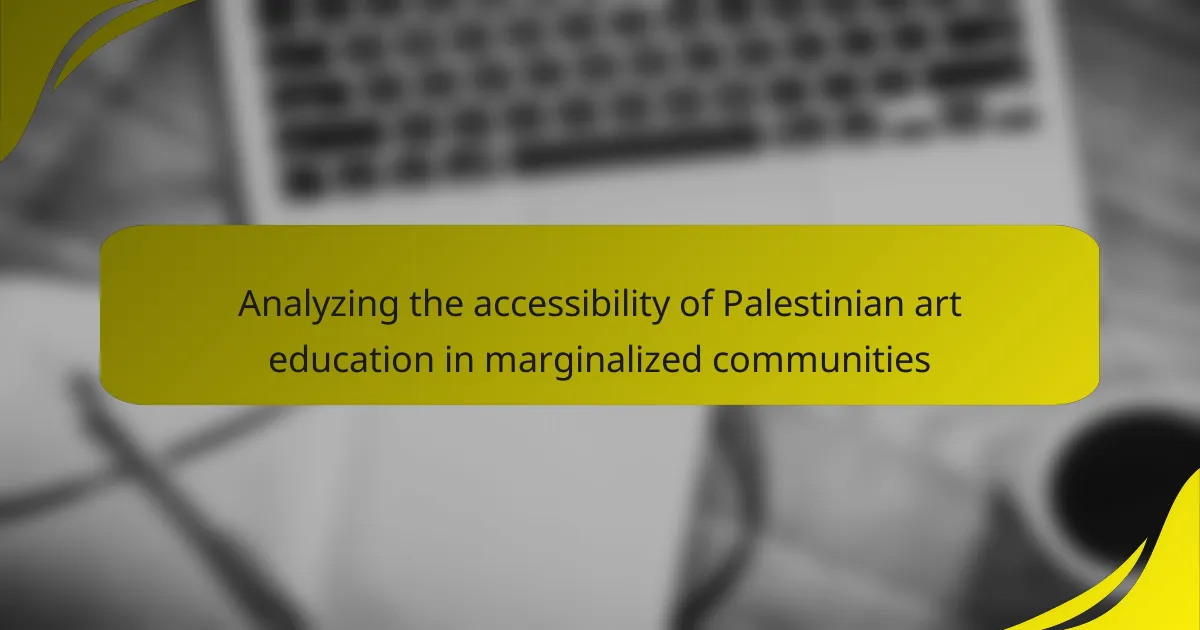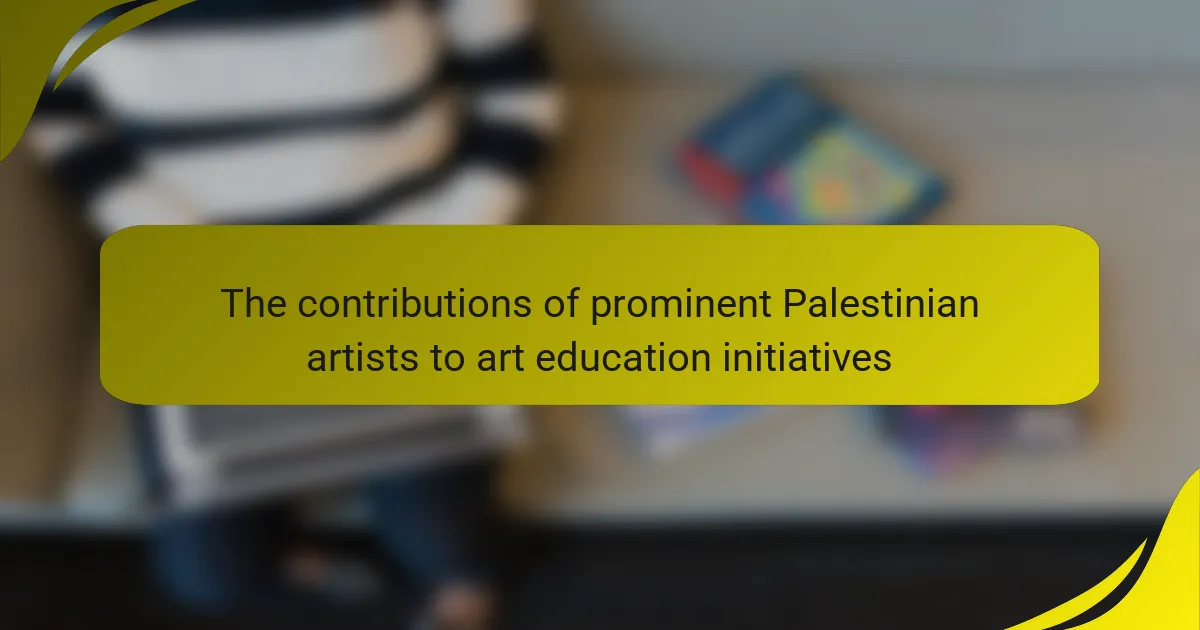Palestinian art education is shaped by the influence of global artistic movements, incorporating diverse styles and techniques from international art trends. This integration enables Palestinian artists to convey their distinct cultural narratives, often addressing themes of identity and resistance. Art institutions in Palestine support this fusion by offering programs that highlight local heritage alongside global practices. The resulting dialogue between Palestinian art and international movements is evident in the growing number of exhibitions featuring Palestinian artists worldwide, underscoring the global relevance of their work within broader artistic discussions.
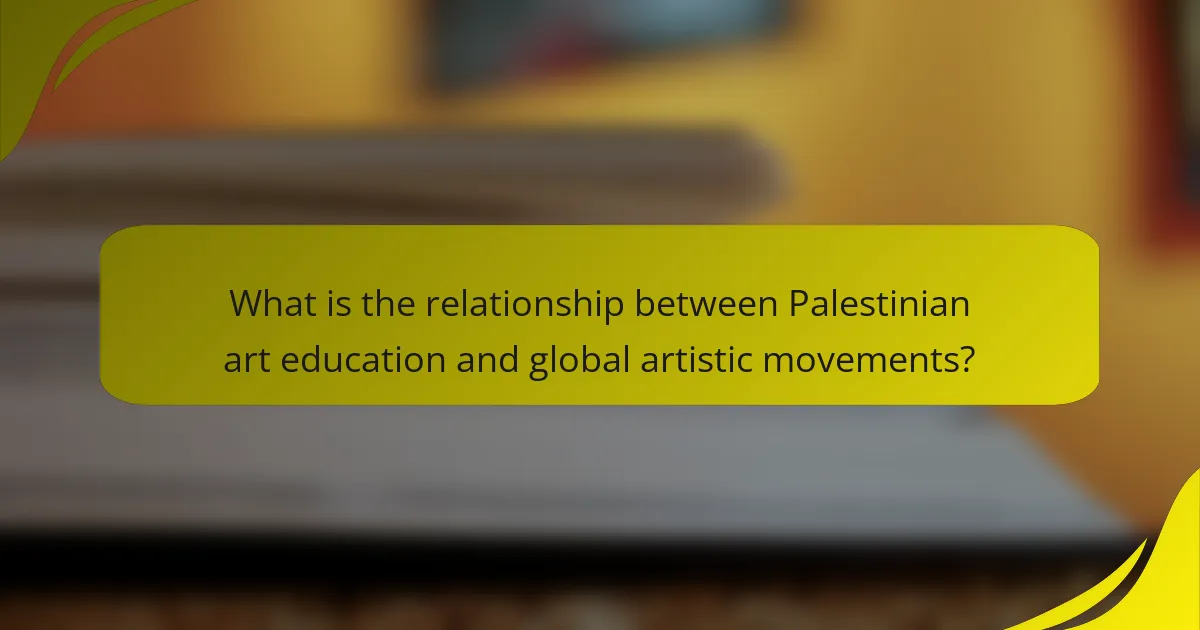
What is the relationship between Palestinian art education and global artistic movements?
Palestinian art education is significantly influenced by global artistic movements. It incorporates various styles and techniques from international art trends. This integration allows Palestinian artists to express their unique cultural narratives. For example, contemporary Palestinian artists often engage with global themes such as identity and resistance. Art institutions in Palestine promote this blend by offering programs that emphasize both local heritage and global practices. The interaction fosters a dialogue between Palestinian art and international movements. Notably, exhibitions featuring Palestinian artists are increasingly held worldwide, showcasing this relationship. These events highlight the global relevance of Palestinian art within broader artistic discourses.
How has Palestinian art education evolved over time?
Palestinian art education has evolved significantly over time. Initially, it was influenced by traditional crafts and local cultural expressions. In the 20th century, the rise of nationalism began to shape artistic curricula. Institutions like the Bezalel Academy in Jerusalem laid foundational structures for art education. The establishment of universities in the West Bank and Gaza further developed formal art programs.
In the 1980s, art education began to incorporate contemporary global movements. This included exposure to modernist and postmodernist theories. The Oslo Accords in the 1990s facilitated international collaborations and exchanges. Today, Palestinian art education emphasizes both local identity and global artistic trends. It fosters critical thinking and social engagement among students.
What historical factors have influenced Palestinian art education?
Palestinian art education has been influenced by historical factors such as colonialism, conflict, and cultural heritage. The British Mandate period introduced Western artistic techniques. This period also saw the establishment of formal art institutions. The 1948 Nakba led to displacement, affecting access to education. The ongoing Israeli-Palestinian conflict has further complicated educational structures. Cultural resistance movements have emerged, integrating traditional Palestinian themes into art education. International influences from global artistic movements have also shaped curricula. These factors collectively reflect the resilience and adaptability of Palestinian art education amidst historical challenges.
How do cultural narratives shape art education in Palestine?
Cultural narratives significantly shape art education in Palestine. These narratives reflect the historical, social, and political experiences of the Palestinian people. They influence the themes, techniques, and mediums taught in art education. For instance, students often explore topics of identity, resistance, and heritage in their artwork. This focus stems from the broader context of Palestinian culture and history. Additionally, cultural narratives foster a sense of community and belonging among students. They encourage the preservation of cultural identity through artistic expression. Art educators in Palestine often integrate these narratives into their curricula. This approach helps students connect their personal experiences with their artistic practices.
What are the key global artistic movements that impact Palestinian art education?
Key global artistic movements that impact Palestinian art education include modernism, postmodernism, and conceptual art. Modernism introduced new forms and ideas, influencing Palestinian artists to explore abstraction and expression. Postmodernism challenged traditional narratives, encouraging critical thinking and diverse perspectives in art education. Conceptual art emphasized the idea over the medium, prompting Palestinian educators to focus on the conceptual aspects of creativity. These movements collectively shape the curriculum and teaching methods in Palestinian art institutions, fostering a rich dialogue between local and global artistic practices.
How do modernism and postmodernism reflect in Palestinian art education?
Modernism and postmodernism significantly influence Palestinian art education. Modernism emphasizes innovation and abstraction, which are evident in the curriculum focusing on new techniques and materials. This approach encourages students to explore their identities and societal issues through a contemporary lens. Postmodernism, on the other hand, introduces concepts of fragmentation and plurality. This reflects in art education by promoting diverse perspectives and questioning traditional narratives. Palestinian artists often blend these movements, creating art that addresses local histories and global contexts. Educational programs incorporate these elements to foster critical thinking and creativity. This combination prepares students to engage with both local and international art scenes.
What role does contemporary art play in shaping Palestinian artistic identity?
Contemporary art plays a crucial role in shaping Palestinian artistic identity. It serves as a medium for expressing cultural narratives and political struggles. Artists use contemporary art to address issues of identity, displacement, and resistance. This form of art reflects the complexities of Palestinian life and history. Through various mediums, artists communicate their experiences and perspectives. Exhibitions and installations often engage with global artistic movements. This interaction fosters a dialogue between local and international audiences. For instance, the work of artists like Emily Jacir and Mona Hatoum has gained global recognition. Their art challenges stereotypes and promotes understanding of Palestinian culture. Thus, contemporary art is essential in defining and redefining Palestinian artistic identity.
In what ways do Palestinian artists engage with global artistic trends?
Palestinian artists engage with global artistic trends through collaboration, adaptation, and participation in international exhibitions. They often incorporate global styles and techniques into their work while maintaining cultural identity. Many Palestinian artists participate in global art fairs and biennials, showcasing their perspectives. This exposure allows them to connect with international audiences and other artists. Additionally, online platforms enable Palestinian artists to share their work globally. They also draw inspiration from global social movements, reflecting contemporary issues in their art. This engagement enriches both their practice and the global art scene.
How do Palestinian artists incorporate global influences into their work?
Palestinian artists incorporate global influences into their work by blending traditional techniques with contemporary styles. They often draw inspiration from international art movements such as surrealism, abstraction, and pop art. This fusion allows them to express local narratives while engaging with global themes. Artists like Emily Jacir and Khaled Jarrar exemplify this approach, using multimedia and installation art to address universal issues. Their work reflects a dialogue between local identity and global discourse. Additionally, collaborations with international artists further enrich their perspectives. This integration of global influences highlights the interconnectedness of art in a globalized world.
What challenges do Palestinian artists face in accessing global art platforms?
Palestinian artists face significant challenges in accessing global art platforms. These challenges include political restrictions that limit mobility and exposure. The ongoing conflict affects their ability to travel for exhibitions and collaborations. Many artists experience difficulties in securing funding and resources. Limited access to international networks hinders their visibility. Additionally, cultural and economic barriers restrict opportunities for showcasing their work. The lack of representation in global art discourse further marginalizes their contributions. These factors collectively impede Palestinian artists from fully engaging with the global art community.
What collaborative opportunities exist between Palestinian art education and global movements?
Collaborative opportunities between Palestinian art education and global movements include cultural exchanges and joint exhibitions. Cultural exchanges allow Palestinian artists to share their work internationally. This enhances visibility and fosters understanding of Palestinian perspectives. Joint exhibitions can showcase Palestinian art alongside global artistic movements. Such collaborations create dialogue and highlight shared themes. Partnerships with international art institutions can provide resources and training. This strengthens the skills of Palestinian artists. Global movements advocating for social justice can align with Palestinian narratives. This amplifies the impact of both the movements and the artists involved.
How can partnerships enhance the visibility of Palestinian art on a global scale?
Partnerships can enhance the visibility of Palestinian art on a global scale by creating collaborative platforms for artists. These partnerships can involve cultural institutions, galleries, and international art organizations. Collaborative exhibitions showcase Palestinian artists to wider audiences. Joint projects often lead to increased media coverage and public interest. Partnerships can facilitate artist residencies that provide exposure to different artistic practices. Educational exchanges can broaden understanding and appreciation of Palestinian art. Networking opportunities through partnerships can connect Palestinian artists with global art markets. This exposure can lead to greater representation in international art fairs and events.
What initiatives foster cross-cultural exchanges in art education?
Initiatives that foster cross-cultural exchanges in art education include international art residencies and collaborative projects. These programs allow artists and educators from different cultures to work together. For example, the UNESCO Creative Cities of Literature initiative promotes cultural exchanges through literature and art. Additionally, exchange programs between universities facilitate student interactions and shared artistic practices. Such initiatives enhance understanding and appreciation of diverse artistic traditions. Evidence shows that these exchanges lead to enriched curricula and innovative teaching methods in art education.
How can Palestinian art education be strengthened through global perspectives?
Palestinian art education can be strengthened through global perspectives by integrating diverse artistic methodologies and practices. Collaborations with international artists can provide fresh insights and techniques. Exposure to global art movements encourages innovation and critical thinking among students. Implementing exchange programs allows Palestinian artists to share their narratives while learning from others. Access to international art resources enhances the curriculum and broadens artistic horizons. Global perspectives foster cultural dialogue, enriching the understanding of local art within a worldwide context. This approach can lead to increased visibility and appreciation of Palestinian art on global platforms.
What best practices can be adopted from global art education models?
Global art education models emphasize interdisciplinary approaches. These models integrate various subjects, fostering creativity and critical thinking. Collaborative projects are common, encouraging teamwork among students. They often utilize community engagement, connecting art with local cultures. Technology is integrated, enhancing learning experiences through digital tools. Continuous professional development for educators is prioritized, ensuring they stay updated with trends. Assessment methods focus on process and growth, rather than just final outcomes. These practices enhance student engagement and broaden artistic perspectives.
How can technology facilitate international collaboration in art education?
Technology facilitates international collaboration in art education by providing platforms for communication and resource sharing. Online tools like video conferencing enable real-time interaction between artists and educators across borders. Digital galleries allow for the exhibition of artwork from diverse cultures, promoting cross-cultural dialogue. Collaborative projects can be managed through cloud-based applications, allowing participants to contribute regardless of location. Social media platforms foster community engagement and outreach, connecting students and educators globally. Research indicates that technology enhances access to art education resources, as seen in initiatives like the UNESCO Creative Cities of Media Arts. These advancements create opportunities for joint exhibitions and workshops, enriching the artistic experience for all participants.
What practical steps can be taken to promote Palestinian art education globally?
Establishing partnerships with international art institutions can promote Palestinian art education globally. These partnerships can facilitate exchange programs for students and artists. Hosting exhibitions of Palestinian art in global art hubs increases visibility. Creating online platforms for showcasing Palestinian art and educational resources expands reach. Offering scholarships for Palestinian students in art programs abroad enhances access to quality education. Collaborating with global art educators can integrate Palestinian perspectives into broader curricula. Engaging in social media campaigns raises awareness of Palestinian art initiatives. Supporting local artists through funding and resources strengthens the community and its global presence.
The main entity of the article is Palestinian art education and its relationship with global artistic movements. The article explores how Palestinian art education is influenced by international trends, incorporating diverse styles and techniques while expressing unique cultural narratives. It examines the evolution of art education in Palestine, historical factors impacting its development, and the significance of cultural narratives in shaping artistic practices. Additionally, the article addresses the challenges faced by Palestinian artists in accessing global platforms and highlights collaborative opportunities that enhance visibility and foster cross-cultural exchanges in art education. Key global movements such as modernism and postmodernism are also discussed in relation to their impact on Palestinian artistic identity.
